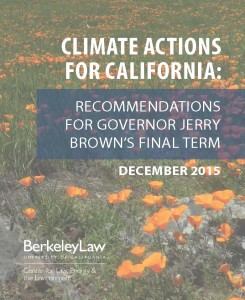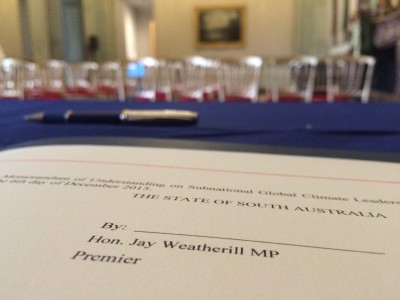In Paris this month, much of the talk related to California’s successful efforts to date in reducing carbon emissions while growing the economy. Certainly the state has made significant progress in areas like renewable energy and electric vehicles, and Governor Brown and his administration deserve a lot of credit.
 But more progress will be needed to meet the state’s much more aggressive mid-century goals of reducing emissions 80 percent over 1990 levels. The state will need both to build on existing programs and to address new areas that are key to decarbonizing the state’s economy, such as natural resources, water and land use.
But more progress will be needed to meet the state’s much more aggressive mid-century goals of reducing emissions 80 percent over 1990 levels. The state will need both to build on existing programs and to address new areas that are key to decarbonizing the state’s economy, such as natural resources, water and land use.
With just over three years remaining in Governor Brown’s final term, Berkeley Law’s Center for Law, Energy and the Environment (CLEE) is today releasing the new report “Climate Actions For California: Recommendations for Governor Jerry Brown’s Final Term.” The report details immediate steps that administration leaders, environmental and energy advocates, and other stakeholders can take to achieve additional short-term successes and create a foundation for long-term progress that endures beyond the administration.
“Climate Actions for California” contains recommendations based on interviews and a convening with Brown Administration officials, agency leaders, philanthropic representatives, and environmental experts.
Among the key recommended solutions:
- A state data platform to better share existing data and collect new data on pressing environmental challenges, particularly on water management and renewable energy planning;
- Improved inter-agency coordination on climate actions, particularly on demonstration projects to reduce emissions that can quickly scale statewide and for collaborating on efforts with new sources of funding;
- More collaborative regional conservation planning to facilitate advance mitigation for new projects and smart development going forward, among other benefits; and
- Enhanced transportation and land use planning that achieves greater co-benefits on water management and resource conservation.
The report provides more detail on these and other recommendations and also summarizes the key challenges that many of the experts we consulted identified, as well as possible next steps and partnerships. Ultimately, these actions could help Governor Brown build on an already-successful climate legacy and ensure that the progress to date continues, not just in California but now across the globe in a post-Paris world.
 What started as a series of informal conversations about a year ago among Governor Brown, his senior staff, and a few world leaders, has turned into a veritable global movement. The “Under 2 MOU,” which I blogged about on Thursday, just bumped its total from 57 signatories last week to 80 today, with each representing a city, state or region around the world that is pledging to limit global warming to under 2 degrees by 2100. That signatory number is expected to increase further this week during the UN climate negotiations in Paris.
What started as a series of informal conversations about a year ago among Governor Brown, his senior staff, and a few world leaders, has turned into a veritable global movement. The “Under 2 MOU,” which I blogged about on Thursday, just bumped its total from 57 signatories last week to 80 today, with each representing a city, state or region around the world that is pledging to limit global warming to under 2 degrees by 2100. That signatory number is expected to increase further this week during the UN climate negotiations in Paris.
Governor Brown and the U.S. Ambassador to France, Jane Hartley (fresh off hosting President Obama at her residence), co-hosted a signing ceremony at the Ambassador’s Residence in Paris today, which I attended as part of Berkeley Law’s sponsorship of the luncheon that followed.
The signing ceremony included signatory states and regions from places like Brazil, Holland, and Australia, as well as cities closer to home like Austin and Oakland. The event featured a press conference with remarks from the ambassador, governor, and a representative from the German state of Baden-Württemberg, which launched this effort with California earlier this year. With 30 media representatives in attendance, the hope is that this effort will get strong publicity both in California and around the world to encourage international negotiators this week in Paris to strike a more aggressive climate agreement.

Governor Brown addresses the luncheon following the Under 2 MOU signing.
In the luncheon that followed for Brown Administration officials, California’s business delegation, and other environmental leaders and elected officials from around the globe, Governor Brown noted that even the “Under 2” goal by 2100 many not be enough. Scientists say that even with two degrees warming, it only gives humanity a 50% chance at averting catastrophic climate change. “I don’t know about you,” Brown said, “but how many of us would board an airplane if it only had a 50% chance of not crashing? I want to see that 50% chance of catastrophe become 0%.”
But short of changing the name to the less-catchy “Under 1.5” MOU, this subnational effort may be one of the best chances that climate advocates have for pushing strong, global action on climate change. Particularly with the international process getting bogged down by deference to the lowest common denominator, as Ted and Cara have blogged about, an agreement among more progressive subnationals could lay the foundation for strong global coordination, albeit at a different level than what negotiators will hopefully be finalizing this coming week.
Credit for this Under 2 MOU certainly goes to the governor and other elected officials, but also to his senior advisor (and Legal Planet guest-blogger) Ken Alex, who helped brainstorm the idea, as well as a dedicated staff from California’s “State Department” in the Brown Administration. With so many roadblocks on the U.S. national and international scene, it’s encouraging to see how much progress California is making at home and now globally.


